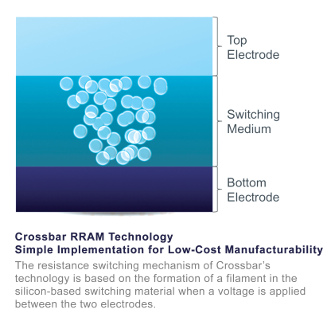Flash Killer? Crossbar Reveals New Disruptive Class of RRAM
Crossbar plans to bring its first product to market in the embedded SOC market.
Start-up company Crossbar Inc. emerged from stealth mode on Tuesday to reveal a new class of Resistive RAM (RRAM) technology that could potentially disrupt the NAND Flash industry. The company said it's new generation of non-volatile memory is capable of storing up to 1 terabyte (TB) on a single 200mm2 chip, enabling users to store 250 hours of HD movies on an IC smaller than a postage stamp.
"Due to its simple three-layer structure, Crossbar technology can be stacked in 3D, delivering multiple terabytes of storage on a single chip," the company said. "Its simplicity, stackability and CMOS compatibility enable logic and memory to be easily integrated onto a single chip at the latest technology node, a capability not possible with other traditional or alternative non-volatile memory technologies."
Crossbar's RRAM solution is based on three simple layers: a non-metallic bottom electrode, an amorphous silicon switching medium, and a metallic top electrode. The resistance switching mechanism is based on the formation of a filament in the switching material when a voltage is applied between the two electrodes. Crossbar's RRAM can be easily incorporated into the back-end-of-line of any standard CMOS manufacturing fab, the company said.
In addition to the potential storage capabilities, the company's RRAM promises to deliver 20x faster write performance, 20x lower power consumption, and 10x the endurance at half the die size when compared to today's "best-in-class" NAND Flash memory. It has a large on/off ratio that improves as cell size shrinks, and provides 1/10th of programming current for low-power applications, 2 to 4 times more data (MLC) and 1 to 3 more stacking layers for greater density.
The company said the cell's low temperature allows it to be stacked in multiple memory array layers on top of the controller CMOS. Larger arrays and higher densities are possible thanks to a lack of joule heating eliminating cross talk between cells during the switching event. Cell switching is based on field dependent switching, leading to no read or program disturb below the critical field.
Crossbar said it has also developed a working Crossbar memory array at a commercial fab, signaling a readiness to begin the first phase of commercialization. The company plans to bring to market standalone chip solutions, optimized for both code and data storage, used in place of traditional NOR and NAND Flash memory. There are even plans to license the technology to system-on-chip (SoC) developers for integration into their next-generation chips.
"Today’s non-volatile memory technologies are running out of steam, hitting significant barriers as they scale to smaller manufacturing processes," said George Minassian, chief executive officer, Crossbar, Inc. "With our working Crossbar array, we have achieved all the major technical milestones that prove our RRAM technology is easy to manufacture and ready for commercialization. It’s a watershed moment for the non-volatile memory industry."
Get Tom's Hardware's best news and in-depth reviews, straight to your inbox.
For more information about Crossbar's RRAM, head here.

Kevin Parrish has over a decade of experience as a writer, editor, and product tester. His work focused on computer hardware, networking equipment, smartphones, tablets, gaming consoles, and other internet-connected devices. His work has appeared in Tom's Hardware, Tom's Guide, Maximum PC, Digital Trends, Android Authority, How-To Geek, Lifewire, and others.
-
IndignantSkeptic And like all amazing breakthrough disruptive technologies that will save humanity from the apocalypse....it will be ready in a few decades for commercialisation once it has satisfactorily assured the Republicans that it will not open a rift directly to the bad place from their favourite children's story-book.Reply -
zzz_b You must be an Obama fan(atic) to bring up any political party for the article.Reply
What a moron!!! -
tntom No word on write cycles? How does this compare to ReRAM? It says they can incorporate logic in the chip. Is this NAND or NOR logic gates? Could this lead to 3D microprocessors? What is the switching rate compared to conventional silicone transistors?Reply -
RealBeast Reply
The endurance is phenomenal at 1E6 compared to 3000 or less for current NAND. HERE is a great chart that compares NAND and RRAM. RRAM appears to be much better in every way.11308608 said:No word on write cycles? How does this compare to ReRAM? It says they can incorporate logic in the chip. Is this NAND or NOR logic gates? Could this lead to 3D microprocessors? What is the switching rate compared to conventional silicone transistors?

